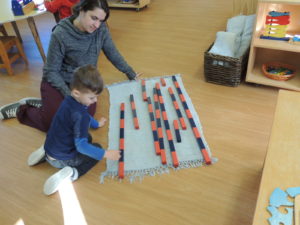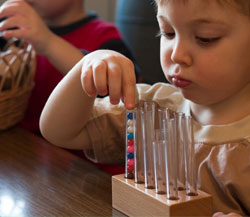There is a clear sense of purpose evident in the classroom.
This current of positive energy belies the structure and foundation of the Montessori educational approach. Both the learning materials and the role of the teacher are key.
The Role of the Teacher:
The teacher has one clear defined purpose: To connect the child with the materials.
The teacher ensures that each child receives lessons and builds their skills with the learning materials. Through individualized lesson planning and record keeping, the teacher tracks the progress of each child. This gives every child the opportunity to work at their own pace and readiness in all areas of the program.
The Materials:
The learning materials are set up as activities on trays or in boxes and arranged on shelves at child height. The teacher shows the work to the child, gives the lesson, and invites the child to repeat the work on their own. The teacher will repeat the lesson if necessary to reinforce the concept. When the skill has been mastered, the teacher will give the next lesson that follows.
Each activity:
- exhibits one quality of the environment
- has one clear defined purpose
- builds on the previous skill
- progresses in sequence from one lesson to the next.
Long rods:
All of the learning materials communicate the concepts necessary for a strong foundation with focus, concentration, and the academic work of reading, writing, and mathematics.
- First lesson with the long rods:
The red rods define and teach the quality of “length”. These are a set of 10 red, wood rods; each differing in one respect: Length. - Math lesson with the rods:
A similar set of rods in the math area are red and blue in alternate decimeters. The purpose now is to teach the names of the numbers as a concrete and separate quantity. - Language lesson with the rods:
Games are played with the rods to teach comparisons and superlatives: long, longer, longest; short, shorter, shortest.
Self-lead learning
At each level of development, the 3, 4, and 5 year olds have the opportunity to work both independently, and with their peers.
The children are free to move about independently as they choose their work and interact with their peers. There is an energetic and lively feeling to the environment. The classroom has a variety of child-sized tables that can seat one, two or a few children. There is floor space left open for large work done more comfortably at a mat.
It is this carefully planned and organized structure of the Montessori curriculum that allows for a fluid and dynamic classroom.








